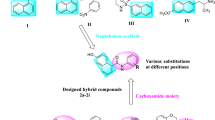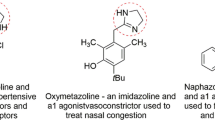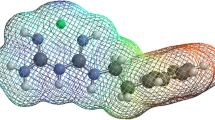Abstract
We investigated the relationship between the chemical structure of acetylcholinesterase (AChE; EC 3.1.1.7) reactivators and their potency in reactivating this enzyme, after prior inhibition by VX (O-ethyl-S-(2-diisopropylaminoethyl)-methylthiophosphonate), tabun, sarin, and cyclosarin. The oximes, pralidoxime (2-PAM), HI-6 [1-(2-hydroxyiminomethylpyridinium)-3-(4-carbamoylpyridinium)-2-oxa-propane dichloride], obidoxime and HS-6 [1-(2-hydroxyiminomethylpyridinium)-3-(3-carbamoylpyridinium)-2-oxa-propane dichloride] were used as representatives of the group of AChE reactivators. Rat brain AChE was used as the appropriate source of the enzyme. Our results confirm that there is no single broad-spectrum oxime suitable for the treatment of poisoning with all highly toxic organophosphorus agents.
Similar content being viewed by others
References
Cabal J, K Kuca and J Kassa (2004) Specification of the structure of oximes able to reactivate tabun inhibited acetylcholinesterase.Basic Clin. Pharmacol. Toxicol. 95, 81–86.
Dawson RM (1994) Review of oximes available for treatment of nerve agent poisoning.J. Appl. Toxicol. 14, 317–331.
De Jong LPA, HP Benschop, GR Van Den Berg, GZ Wolring and DC Korte (1981) Reactivation of tabun-inhibited acetyl cholinesterase by 1-(hetero)arylmethyl-pyridinium-oximes.Eur. J. Med. Chem. - Chim. Therap. 16, 257–262.
Kassa J (2002) Review of oximes in the antidotal treatment of poisoning by organophosphorus nerve agents.J. Toxicol. Clin. Toxicol. 40, 803–816.
Kassa J and J Cabal (1999a) A comparison of the efficacy of acetylcholinesterase reactivators against cyclohexyl methylphosphonofluoridate (GF Agent) byin vitro andin vivo methods.Pharmacol. Toxicol. 84, 41–45.
Kassa J and J Cabal (1999b) A comparison of the efficacy of a new asymmetric bispyridinium oxime BI-6 with presently used oximes and H oximes against sarin byin vitro andin vivo methods.Hum. Exp. Toxicol. 18, 560–565.
Kuca K and J Kassa (2003) A comparison of the ability of a new byspyridinium oxime-1-(hydroxyiminomethylpyridinium)-4-(4-carbamoylpyridinium)butane dibromide and currently used oximes to reactivate nerve agent-inhibited rat brain acetylcholinesterase byin vitro methods.J. Enzyme Inhib. Med. Chem. 18, 529–535.
Kuca K and J Kassa (2004) Oximes-induced reactivation of rat brain acetylcholinesterase inhibited by VX agent.Hum. Exp. Toxicol. 23, 167–171.
Kuca K, J Bielavsk”, J Cabal and J Kassa (2003a) Synthesis of a new reactivator of tabun-inhibited acetylcholinesterase.Bioorg. Med. Chem. Lett. 13, 3545–3547.
Kuca K, J Bielavsk”, J Cabal and M Bielavská (2003b) “Synthesis of a potential reactivator of acetylcholinesterase 1-(4-hydroxy-iminomethylpyridinium)-3 -(carbamoyl pyridinium)-propane dibromide.Tetrahedron Lett. 44, 3123–3125.
Kuca K, J Cabal, J Patocka and V Dohnal (2004a) Quaternary heteroarenium salts as the competitive inhibitors of the brain acetylcholinesterase.Lett. Drug Des. Disc. 1, 97–100.
Luo Ch, H Leader, Z Radic, DM Maxwell, P Taylor, BP Doctor and A Saxena (2003) Two possible orientations of the HI-6 molecule in the reactivation of organophosphate-inhibited acetylcholinesterase.Biochem. Pharmacol. 66, 387–392.
Marrs TC (1993) Organophosphate poisoning.Pharmacol. Ther. 58, 51–66.
Pang YP, TM Kollmeyer, F Hong, J Ch Lee, PL Hammond, SP Haugabouk and S Brimijoin (2003) Rational design of alkylenelinked bis-pyridiniumaldoximes as improved acetylcholinesterase reactivators.Chem. Biol. 10, 491–502.
Patocka J, J Bielavsk” and F Ornst (1970) Reactivating effect of alpha, omega-bis-(4-pyridinealdoxime)-2-trans-butene dibromide on isopropyl-methylphosphonylated acetylcholinesterase.FEBSLett. 5, 182–184.
Puu G, E Artursson and G Bucht (1986) Reactivation of nerve agent inhibited human acetylcholinesterase by HI-6 and obidoxime.Biochem. Pharmacol. 35, 1505–1510.
ěvcíková K, F Hampl, F Liπka, J Cabal and J Patocka (1998) Substituted pyridinium derivatives as inhibitors of acetylcholinesterase.Voj. Zdrav. Listy - Suppl. 67, 28–31.
Tallarida R and R Murray (1987)Manual of Pharmacological Calculation with Computer Programs (Springer: New York), p 145.
Taylor P (1996) Anticholinergic agents, InThe Pharmacological Basis of Therapeutics (Hardman JG and LE Limbird, Eds.) (McGraw Hill: New York), pp 161–176.
Tuπarová I, E Halámek and Z Kobliha (1999) Study on reactivation of enzyme-inhibitor complexes by oximes using acetylcholin esterase inhibited by organophosphate chemical warfare agents.Enzyme Microb. Technol. 25, 400–403.
Worek F, M Backer, H Thiermann, L Szinicz, U Mast, R Klimmek and P Eyer (1997) Reappraisal of indications and limitations of oxime therapy in organophosphate poisoning.Hum. Exp. Toxicol. 16, 466–472.
Worek F, R Widmann, O Knopffand and L Szinicz (1998) Reactivating potency of obidoxime, pralidoxime, HI-6 and HLö-7 in human erythrocyte acetylcholinesterase inhibited by highly toxic organophosphorus compounds.Arch. Toxicol. 72, 237–243.
Yang GY, JH Yoon, CM Seong, NS Park and YS Jung (2003) Synthesis of bis-pyridinium oxime antidotes using bis(methylsulfonoxymethyl) ether for organophosphate nerve agents.Bull. Korean Chem. Soc. 24, 1368–1370.
Author information
Authors and Affiliations
Corresponding author
Rights and permissions
About this article
Cite this article
Kuca, K., Patocka, J., Cabal, J. et al. Reactivation of organophosphate-inhibited acetylcholinesterase by quaternary pyridinium aldoximes. neurotox res 6, 565–570 (2004). https://doi.org/10.1007/BF03033452
Received:
Revised:
Issue Date:
DOI: https://doi.org/10.1007/BF03033452




